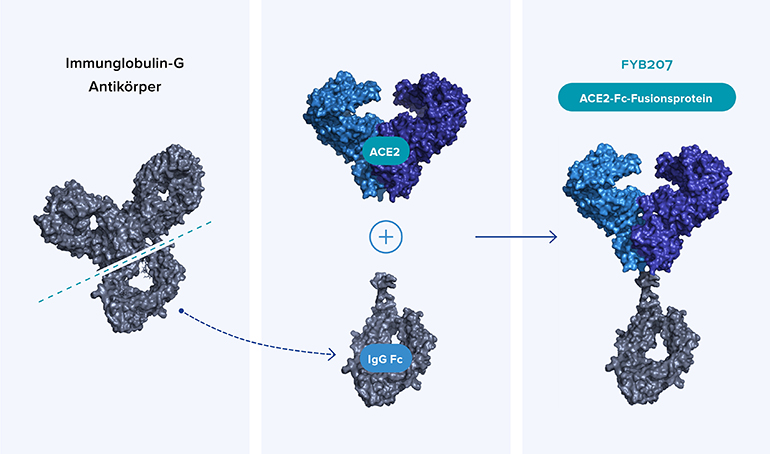Researchers at the Technical University of Munich have developed a new protein therapeutic against SARS-CoV-2. Unlike previously developed antibody therapies and vaccines, the virus is very unlikely to be able to circumvent this latest technology through mutation because it is based on the viral target site in the body, the ACE2 receptor. The technology consists of the ACE2 protein, which the researchers fused with a fragment of a human antibody so that it would remain stable in the body for longer. Once administered, viral particles bind to the fusion protein in the body, preventing them from attaching to a cell and deactivating it.
SARS-CoV-2 continues to be a formidable opponent and how the pandemic will develop is still unknown. Despite our advances in rapidly developing vaccines and antibody treatments in response to the pandemic, new variants of the virus have shown signs of immune escape, finding new avenues around our innate immune defenses or exogenously administered antibody therapies. While vaccinations are probably our greatest hope in protecting against serious illness, it would be very useful to find new treatments that are difficult for the virus to circumvent.
“Both vaccines and antibody drugs have the same problem: the virus manages to bypass them just a little more with every successful mutation,” says Ulrike Protzer, a researcher involved in the study. “This creates so-called immune escape variants.”
 The FYB207 fusion protein contains the part of the ACE2 protein that the virus needs to dock and part of the human immunoglobulin IgG4. By blocking the virus’ spike proteins, FYB207 successfully prevents infection in cell culture experiments. Image: Formycon AG
The FYB207 fusion protein contains the part of the ACE2 protein that the virus needs to dock and part of the human immunoglobulin IgG4. By blocking the virus’ spike proteins, FYB207 successfully prevents infection in cell culture experiments. Image: Formycon AG
To address this, Protzer and his colleagues focused on the viral target in our body and not on the virus itself. The ACE2 receptor exists on the surface of cells infected with SARS-CoV-2, and thus the virus can penetrate the cells and can reproduce, it has to bind to the receptor. A virus mutation will hardly change that. Therefore, this research group decided to use the ACE2 receptor itself as a therapeutic. On its own, the protein is somewhat fragile and has a tendency to break down in the body, so the researchers fused it with a common human antibody to give it some stability.
“Since the virus needs optimal docking with the ACE2 protein in order to survive, the virus cannot evade a drug that is based precisely on this protein,” says Johannes Buchner, another researcher involved in the study. “This means that the fusion protein will also be reliably effective against future mutations.”
So far, the researchers have shown that the protein therapeutic can inhibit the virus and will soon test it against the latest Omicron variant.
“The SARS-CoV-2 virus and its related variants will continue to challenge mankind in the future,” said Protzer. “Even if vaccination is a very reliable means of preventing severe symptoms during the course of the disease, the significantly more contagious Delta and Omicron variants have shown that both recovered and vaccinated patients can be re-infected. With regard to future, possibly even more contagious variants, in addition to the vaccination we need a broadly effective active ingredient against the virus. “
Here is a video of a comparison of the replication of the GFP-labeled SARS-CoV-2 virus in cell culture. Without FYB207 (left), the virus will spread unhindered. When FYB207 is added (right), the infection is completely suppressed.
Studying Antiviral Research: Picomolar inhibition of worrying SARS-CoV-2 variants by a genetically modified ACE2-IgG4-Fc fusion protein
